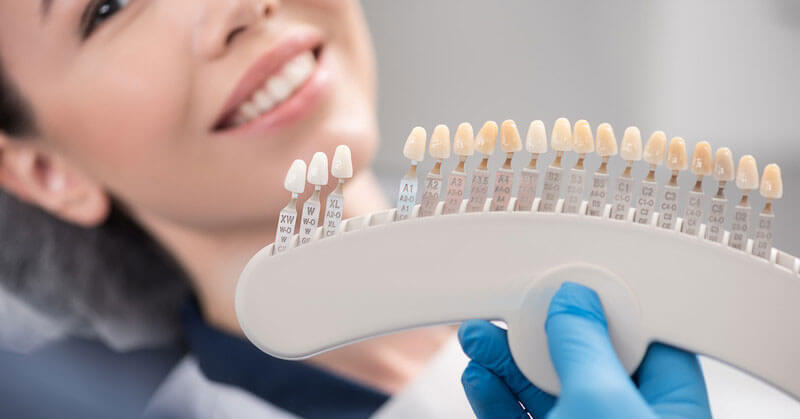A smile is often considered one of the most attractive traits. That is, of course, if a smile features pearly whites that are properly aligned and glowingly white. What if your teeth are darker, though?
You should know that it’s natural for teeth to darken or yellow somewhat with age, but there are a variety of other ways in which teeth could become discolored. The good news is that there are treatment options to regain the beautiful, bright smile of your youth, but you’ll need to start by understanding the types and causes of tooth discoloration. Here’s what you should know.
AGE-RELATED DISCOLORATION
There are two reasons why our teeth appear to yellow as we age. First, the enamel that protects our teeth erodes from wear and tear over time, and this exposes the dentin within. In addition, dentin naturally yellows with time. These two factors mean that as we age, our teeth take on a yellow hue. This is why white teeth are generally associated with youth.
There is a pretty easy fix for this dilemma, though: teeth whitening. You can try over-the-counter products like whitening toothpaste, gels, and strips, but you’re going to see far better results from professional methods of whitening like bleaching trays or in-office laser whitening treatments.
EXTRINSIC DISCOLORATION
This refers to any discoloration that affects the exterior of your teeth, and it is most commonly associated with food stains. The foods and beverages you consume may contain any number of harmful substances that stain your tooth enamel. Coffee, tea, and wine are among the worst offenders because they contain natural staining agents (and many people consume them frequently).
Soda and other foods that contain a lot of chemical dyes can also stain your teeth over time. Of course, the use of tobacco products is another source of extrinsic discoloration. Cutting back on these items can help to prevent extrinsic stains, but if you want to address staining, you’ll find that abrasive toothpaste (like those containing baking soda) can help, as can whitening products and procedures.
INTRINSIC DISCOLORATION
This is a much more difficult type of staining to treat because it is within your teeth instead of on the surface. Intrinsic discoloration could be caused by medications like tetracycline, early exposure to fluoride, tooth trauma, or even a rare condition known as dentinogenesis imperfecta, and the dark, internal stains can be especially hard to get rid of. The best solution is often to hide the stains with bonding or veneers.



14 Comments
Наш веб-портал — известное цифровое медиа.
Мы быстро размещаем значимые новости.
https://rftimes.ru/html/smi.html
Коллектив журналистов стремится предоставлять надёжную информацию.
Оставайтесь с нами, чтобы не пропустить свежие публикации!
I don’t think the title of your article matches the content lol. Just kidding, mainly because I had some doubts after reading the article.
Game Athlon is a popular entertainment platform offering dynamic gameplay for players of all levels.
The site provides a huge collection of slot machines, live dealer games, classic casino games, and sports betting.
Players can enjoy smooth navigation, top-notch visuals, and intuitive interfaces on both computer and smartphones.
http://www.gameathlon.gr
GameAthlon prioritizes player safety by offering trusted payment methods and fair outcomes.
Promotions and VIP perks are constantly improved, giving members extra opportunities to win and have fun.
The helpdesk is on hand day and night, supporting with any inquiries quickly and professionally.
The site is the ideal choice for those looking for fun and huge prizes in one safe space.
Оказываем услуги проката автобусов и микроавтобусов с водителем корпоративным клиентам, малого и среднего бизнеса, а также частным заказчикам.
Прокат микроавтобусов
Мы обеспечиваем комфортную и спокойную поездку небольших и больших групп, предлагая перевозки на свадебные мероприятия, корпоративы, туристические поездки и любые события в городе Челябинске и Челябинской области.
Exquisite wristwatches have long been a gold standard in horology. Meticulously designed by legendary artisans, they perfectly unite tradition with innovation.
All elements embody superior quality, from precision-engineered calibers to premium finishes.
Wearing a timepiece is not just about telling time. It represents refined taste and exceptional durability.
Whether you prefer a classic design, Swiss watches deliver unparalleled beauty that stands the test of time.
http://zalimd.vs120132.hl-users.com/violencia/phpBB3/viewtopic.php?f=2&t=861
Swiss watches have long been a benchmark of excellence. Expertly made by renowned brands, they seamlessly blend classic techniques with cutting-edge engineering.
Each detail demonstrate superior workmanship, from hand-assembled movements to premium elements.
Wearing a horological masterpiece is not just about telling time. It represents timeless elegance and exceptional durability.
Be it a minimalist aesthetic, Swiss watches provide extraordinary beauty that never goes out of style.
https://www.bookup.com/forum/viewtopic.php?f=6&t=115034
Luxury timepieces have long been a gold standard in horology. Expertly made by world-class artisans, they combine heritage with innovation.
Every component reflect unmatched quality, from intricate mechanisms to luxurious materials.
Investing in a timepiece is a true statement of status. It signifies timeless elegance and exceptional durability.
No matter if you love a minimalist aesthetic, Swiss watches offer unparalleled beauty that stands the test of time.
https://mobilion.ir/forum/index.php?threads/%D9%81%D9%84%D8%B4-yoga_smart_tab-t-x705x-lenovoy.2983/#post-172164
You can find a wide range of trusted pharmaceutical products for different conditions.
This website guarantees fast and reliable delivery to your location.
Every item is supplied by licensed suppliers so you get safety and quality.
Easily explore our selection and get your medicines in minutes.
Need help? Customer service are here to help 24/7.
Prioritize your well-being with reliable online pharmacy!
https://anuneo.fr/centre-medical-dispensaire-marseille-societe-civile-de-moyens-les-marronniers
Оформление сертификатов в нашей стране по-прежнему считается ключевым условием выхода продукции на рынок.
Этот процесс гарантирует соответствие установленным требованиям государственным стандартам и правилам, что, в свою очередь, гарантирует защиту потребителей от небезопасной продукции.
оформление сертификатов
Также наличие сертификатов способствует сотрудничество с заказчиками и повышает конкурентные преимущества для бизнеса.
Без сертификации, может возникнуть штрафы и ограничения в процессе реализации продукции.
Таким образом, получение сертификатов не просто формальностью, и мощным инструментом для успешного развития компании на отечественном рынке.
Прохождение сертификации на территории РФ по-прежнему считается неотъемлемым процессом легальной реализации товаров.
Этот процесс подтверждает соответствие установленным требованиям техническим регламентам и правилам, что, в свою очередь, оберегает конечных пользователей от фальсификата.
обязательная сертификация
Кроме того, сертификация помогает взаимодействие с заказчиками и расширяет конкурентные преимущества на рынке.
При отсутствии сертификатов, может возникнуть штрафы и ограничения при продаже товаров.
Таким образом, получение сертификатов не только требованием законодательства, а также залогом устойчивого роста организации в сфере торговли.
Even with the popularity of smartwatches, mechanical watches remain everlasting.
A lot of enthusiasts value the artistry that goes into classic automatics.
In contrast to smartwatches, which become outdated, classic timepieces hold their value for decades.
http://forum.royanmama.com/showthread.php?tid=78
Luxury brands still produce limited-edition mechanical models, confirming that their desirability is as high as ever.
To a lot of people, a traditional wristwatch is not just an accessory, but a symbol of craftsmanship.
While smartwatches offer convenience, traditional timepieces carry history that remains unmatched.
Чем интересен BlackSprut?
Сервис BlackSprut удостаивается обсуждения многих пользователей. Почему о нем говорят?
Данный ресурс обеспечивает интересные опции для аудитории. Визуальная составляющая платформы отличается простотой, что делает платформу интуитивно удобной без сложного обучения.
Стоит учитывать, что этот ресурс работает по своим принципам, которые делают его особенным на рынке.
При рассмотрении BlackSprut важно учитывать, что различные сообщества выражают неоднозначные взгляды. Одни отмечают его удобство, а некоторые оценивают его с осторожностью.
В целом, BlackSprut остается предметом обсуждений и привлекает заинтересованность разных слоев интернет-сообщества.
Доступ к BlackSprut – проверьте здесь
Если нужен обновленный сайт БлэкСпрут, вы на верном пути.
bs2best
Иногда ресурс меняет адрес, поэтому нужно знать актуальное ссылку.
Мы следим за актуальными доменами чтобы предоставить новым линком.
Посмотрите рабочую ссылку у нас!
Наша компания предлагает помощью мигрантов в СПб.
Предоставляем услуги в получении необходимых бумаг, временной регистрации, а также формальностях, для официального трудоустройства.
Наши эксперты разъясняют по миграционным нормам и дают советы оптимальные варианты.
Оказываем поддержку по вопросам временного проживания, а также по получению гражданства.
С нами, вы сможете быстрее адаптироваться, упростить оформление документов и спокойно жить в Санкт-Петербурге.
Обращайтесь, и мы подробно расскажем обо всех возможностях!
https://spb-migrant.ru/
Buying medicine from e-pharmacies has become far easier than visiting a local drugstore.
There’s no reason to stand in queues or stress over limited availability.
Internet drugstores let you get what you need from home.
Many websites have discounts in contrast to brick-and-mortar pharmacies.
https://russiancarolina.com/index.php/topic,126056.new.html#new
Additionally, you can browse various options without hassle.
Fast shipping makes it even more convenient.
Do you prefer purchasing drugs from the internet?